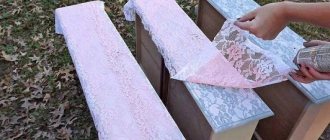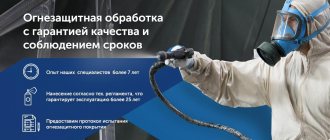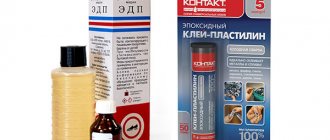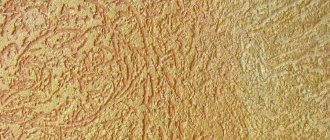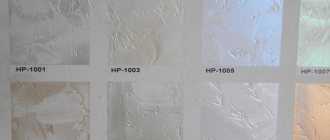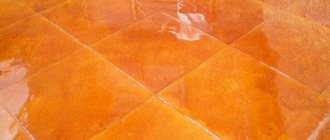Wood fire protection methods
To reliably protect wooden structures, an integrated approach is used, including the following series of measures:
- Cladding with non-combustible materials.
The method includes both decorative finishing and targeted coating of parts of the structure in high-risk areas. For this purpose, plaster, asbestos boards, drywall, tiles, brick and artificial stone, mineral wool, and fabrics are used.
Pros - the ability to impart useful properties to surfaces (noise, moisture, heat insulation, decoration).
Disadvantages - additional costs, weight, reduced free space.
- Introduction into the structure of the structure of elements that prevent the spread of fire.
Fire barriers made of stone or brick are created between individual sectors of the house.
Advantages - with proper and timely organization of fire extinguishing, the method allows you to prevent the spread of fire to neighboring parts of the house or from a nearby object.
Disadvantages - technical construction requires large investments of labor and funds. Does not guarantee complete security.
Treatment of rafters with fire retardant impregnation Source stopfire.su
- Fire-prevention treatment of wooden structures with special compounds that do not support combustion.
Pros – it doesn’t consume additional volume, it’s easy and quick to do.
Disadvantages - the applied products only restrain the fire for a certain time, and do not completely protect against it. Strict adherence to technology is required.
Note! Fire retardant treatment of wooden structures, the frequency of which is regulated by supervisory authorities, is only part of fire prevention measures. The full range of protection methods depends on the characteristics of the building, technical conditions and project. Only a specialized company can optimally determine it.
List of documents provided upon completion of fire protection work
The result of the procedure must be documented. The name of the performing organization, the type of work, a description of the materials used, and the date of completion are indicated. They should be preserved.
List of documents:
- act of ordering and acceptance of completed work;
- certificates for all fire retardants used;
- license of the organization that provided the service;
- invoice (needed by legal entities);
- an expert opinion confirming that the procedure meets all requirements of the industrial safety regulations (provided separately if the client wishes).
Important! The contractor provides his own guarantee, the duration of which depends on the type of fire-resistant compounds.
Wood is a natural flammable material that requires additional protection. It doesn’t matter whether the whole house or individual parts of the building are built from it. Fire retardant treatment is a necessary measure, the implementation of which guarantees the prevention of fire. It should be repeated periodically following the instructions of GOST and the manufacturer.
Types of fireproof impregnations
Based on its ability to resist the combustion process, fireproof impregnation for wood is divided into the following three groups:
- 1 – highest.
When exposed to fire, wood treated with this composition loses no more than 9-10% of its mass. In this case, resistance can last up to 2.5 hours - depending on the depth of penetration of the composition and the number of its layers.
Painting a fence for fire protection Source gidpokraske.ru
- 2 – average.
Wood treated with this composition caught in a flame consumes no more than 25% of the substance. Longevity is about 1.5 hours maximum.
- 3 – minimum.
Weak protection – weight loss can reach 85%.
According to their chemical properties, fire retardant compounds for wooden structures are divided into three main groups:
- Acidic.
- Alkaline.
- Saline.
According to the composite composition and consistency, the products are presented as:
- Paint.
- Lakov.
- Fire retardants.
- Impregnation.
- Past.
Let's look at their features in more detail.
See also: Catalog of companies that specialize in paints and varnishes and related work
Fire retardants
Fire protection for wood of this class is basic and is included in many other products - paints, varnishes, etc. Based on solubility, they are divided into water-soluble and organically soluble. The former are used primarily for processing structures that are not exposed to moisture during operation.
The latter are more resistant to external factors - water, dampness, temperature changes. In addition, thanks to the solvents they contain, they easily penetrate deep into the wood structure. This provides more reliable and long-lasting protection. In most cases, they are used in industrial facilities.
Impregnation of timber with fire-resistant impregnation Source elka-palka.ru
Paints
They consist mainly of fire retardants and a coloring component. Fire protection for wood in the form of paints is divided into two types according to the mechanism of action:
- Intumescent.
Belongs to group 1. During thermal exposure, the layer begins to bubble, increasing in volume up to 30 times and forming a reliable fireproof layer.
- Anti-intumescence.
Contains silicates.
According to their purpose, fire-retardant paints are divided into façade paints and those intended for indoor use.
Lucky
Fire-resistant varnish is a fire protection preparation for wide application. Due to its specificity, it allows you to preserve the natural texture of the wood. Therefore, its main purpose is decoration + fire protection. It is used to treat floors, walls, furniture and other structures and objects.
Impregnations, pastes
Fire-prevention impregnation is intended for deep impregnation of the wood structure and more reliable protection. Other products can be applied on top of it - paints, varnishes. In addition, they often contain antiseptic components that prevent the formation of rot and mold. Thus, impregnating compositions perform a dual function.
Application of fire-resistant varnish Source gid-str.ru
Operating principle and overview of types of OS for wood
A representative of an organization providing such services examines the object. It identifies surfaces that need fire protection. Owners building private houses usually invite such specialists separately. You should choose licensed companies operating in accordance with GOST standards.
External fire escape: requirements of SNiP PPB for buildings
The product with which the structure will be coated is selected based on the material from which the structure is assembled. Substances must:
- be effective;
- ensure a high and long-term level of fire resistance in accordance with all fire safety standards;
- have certifications confirming their quality;
- be low consumption, technologically advanced;
- match the type of working surface;
- have some decorative properties;
- provide for further application of paint and varnish on top.
Note! The finished protective layer retains all useful qualities for 10 years, this is the usual warranty period. You should call a technician later to repeat the procedure.
There are many protective agents, all of them are divided into two functional groups: coatings and impregnations.
Fire protection methods for wood: from classic, time-tested to modern.
| Name | Operating principle |
| Wet plaster | It generously covers the wooden parts of buildings. After waiting for drying, the load-bearing parts (pillars, columns, curtains/partitions) find themselves in a fire-resistant shell. It prevents fire and heat, not just once, but constantly. Therefore, stoves were covered with plaster. |
| A proven, simple and reliable method, although archaic and labor-intensive. Plus it requires periodic updating, because the plaster breaks off in pieces. | |
| Fire retardant coatings, mastics, pastes | A modern interpretation of classic wet plaster. Lime was replaced with a non-flammable binder - water with fillers (clay, salt, vermiculite, superphosphate). |
| The material is applied to the surface with a trowel/trowel. The finished result looks rather rough, so it is suitable for non-residential warehouses, garages and sheds. GOST 25130-82, adopted in the USSR, is in force. | |
| Facing | An effective method of protection. Natural stone, ceramic tiles or decorative brick are used. They are carefully attached to the protected surface. It looks beautiful from the outside. |
| Pros - the fire resistance limit is significantly increased, it looks beautiful, is universal, and will complement any design. Disadvantages: expensive, heavy weight of the structure, difficult to protect small geometric elements. As a result, the volume of premises decreases. | |
| Enamel, paint, varnish | Modern technique. A thin layer of protective agent is enough, and the wood will be protected from smoldering, exposure to elevated temperatures, and open flames. The external structure is completely preserved. Such materials can be used for any item, even small ones. |
| Pros: ease of use, large selection, availability of additional properties. Cons: high cost. | |
| Impregnation with special protective compounds | The most popular method now, it is used by construction companies and manufacturers of various wood products. The principle of fire-prevention wood treatment is coating the structure with an aqueous solution of salts (fire retardants). There is a distinction between superficial and more complex deep impregnation. The first one is used more often. Apply the product to the wood using rollers, brushes or a sprayer. Then the master waits a certain time until the composition is absorbed. The second is more difficult - you need impregnation baths or autoclaves. They are filled with the composition and the objects being processed are immersed there. |
| Pros: deep impact, allowing you to cover the internal structural part. This increases fire resistance. Disadvantages - the procedure is long, expensive and requires equipment (deep impregnation). |
Types of fire fighting equipment
Operating principle of impregnations
Fire-retardant impregnation for wood or its other paint and varnish analogues are based on the principle of deposition of salts included in fire retardants on the treated surface. In this case, the fire prevention mechanism depends on the nature of the components:
- inorganic salts simply settle on the surface, forming a protective layer, and thereby provide flame resistance.
Their main disadvantage is the melting of the salt base and, as a result, the release of the surface for the action of fire. This protection does not last long.
- Organic salts, in addition to purely mechanical protection, create chemical flame resistance. When heated, they decompose into gas and sediment. Gaseous components slow down the combustion process and cool it down, while heavy components penetrate into the pores of the wood, also forming a fire-resistant protective layer.
Recommendation! Fire retardant treatment of wooden structures in the attic of a private house is best achieved using comprehensive protection. Before the boards become part of the rafter system, they are treated with impregnation. When the frame is ready, it is painted. To top it off, if the roof is planned to be insulated, basalt wool or foil rolls are used.
Pre-treatment of timber with fire protection Source 1olestnice.ru
Principles of fire-resistant wood treatment
Fire retardants are made from various types of salts. The level of protection depends on their types. Penetrating into the wood structure, salts together with water can penetrate deeply into the material; after the water evaporates, the salt components remain inside, improving the fire-resistant ability of the wood. Low-quality impregnating solutions are made from inorganic salts, which melt under the influence of fire, which makes fire resistance weaker.
If organic salts are used, then when surrounded by high temperatures, a gas evolution reaction occurs, as a result the material cools. Other substances that protect wood are also released, serving as an obstacle to its ignition.
Fire retardants are made from various types of salts. The level of protection depends on their types.
Requirements, documentation, verification
The frequency of treatment of wooden structures with a fire retardant composition is determined primarily by the service life of the composition and the conditions of their operation. Therefore, the durability of the coating varies from several months to tens of years. The inspection is carried out by fire inspection authorities at least once a year, season or other period established by the manufacturer or contractor.
Moreover, if damage is found during the inspection, the surface is updated immediately. The composition of the impregnating agents for repairs should be similar to those that were originally applied. All work must be included in a special fire act and certified by representatives of inspection authorities.
Important! Fireproof impregnation of wooden structures must be carried out by a specialized organization that has a special license from the Ministry of Emergency Situations. Without this condition, the fire inspector will not be able to sign the inspection report of the completed fire protection.
Fire safety expertise Source stroy-zashita.ru
Checking the quality of fire protection of wood structures
Responsibility for fire protection of wooden structures and ensuring inspection lies with the owner of the structure (premises). The procedure consists of control:
- visual (for cracks, chips, untreated areas);
- instrumental (destructive):
- special equipment - example: PMP 1 device for express testing;
measuring the layer thickness with a feeler gauge;
- checking chips for flammability;
- tests (not in all cases) - impregnation should ensure a loss of material weight of up to 13% according to GOST 16363-98.
Expertise and effectiveness assessment are carried out by licensed specialized institutions, laboratories included in the Rossaccreditation register, and SRO structures. The frequency of the check depends on the schedule in the OS instructions or in the guarantee issued by the contractor.
The wooden structure should not contain unimpregnated segments, cracks, chips, or defects. The layer must meet PPB standards. If deficiencies are found, the supervisory authority issues an order to eliminate the deficiencies and sets a date for the next inspection.
Sample wood fire treatment certificate
A fire protection certificate is issued upon completion of work based on quality control and compliance with fire safety standards. The paper contains characteristics of the mixture, the object, the work performed, as well as the dates of the procedures, the warranty period for the fire retardant treatment, links to standards, and the result.
The processing act is signed and stamped by the participants of the procedure (representatives): contractor, customer, State Fire Supervision. The document is an official confirmation of the presence of fire protection.
Download: Sample processing verification report.pdf
Impregnation selection criteria
Fire retardant impregnation for wood should be selected based on the following criteria:
- Protection group . Information is in the technical documentation from the manufacturer of the product.
- Degree of resistance . Pastes, as well as various non-combustible facing materials, have the maximum value.
- Resistance to external factors . Depends on the location and operating conditions of the impregnation - outdoors or indoors, temperature, humidity.
- Decorative qualities . Varnishes have the maximum effect, pastes have the minimum effect.
- Best before date.
- Recommendations for reapplication.
Good to know! Fire-resistant wood treatment does not aim to create fire-resistant structures. It only slows down the combustion process, localizes the fire and reduces the risk of rapid expansion of its area. In practice, fire-resistant impregnation allows you to gain time to evacuate people from a burning building without harm, and for the firefighter to arrive before the fire spreads globally.
How often should fire protection be carried out on wooden building structures?
Wood processing is necessary before putting the facility into operation. Further, the materials lose their properties and the structures become vulnerable to fire. Repeated work is carried out:
- annually, if the instructions for the protective material do not indicate a warranty period;
- after the period specified in the documents, it can vary from 1 year to 10 years;
- when identifying during inspection areas where the integrity of the coating is compromised.
If violations of the regulations are detected, the regulatory authorities have the right to file claims against the owner of the building or the responsible representative.
Application technology
Impregnation of wood against fire using special compounds is carried out in the following three stages:
- Application of compositions to the surfaces of structures in accordance with the selected project.
- Carrying out a check for the quality of the applied layer, its uniformity and completeness of distribution.
- Drawing up an inspection report.
Good to know! The method of applying fire-fighting compounds is largely determined by the consistency of the product and the ease of its application. Depending on the conditions, these could be brushes, rollers, a spatula, or a spray gun. For more thorough deep processing, the soaking method is also used, including in a hot environment.
Treatment and impregnation of wooden surfaces with a fire retardant compound
Work with fire retardants must be strictly carried out according to the rules prescribed by the manufacturer in the instructions. Each substance may have its own nuances, which are taken into account when working. Actions are also carried out in accordance with NAP standards.
The following steps are carried out step by step:
- Assessment of wood characteristics.
- Analysis of the features of the house.
- Selection of methods and compositions.
- Preparation of the project document.
- Treatment.
- After completion, the result is checked and a fire protection report is drawn up.
Work with fire retardants must be strictly carried out according to the rules prescribed by the manufacturer in the instructions.
Terms of reference for processing
The terms of reference for regulatory documents must contain the following points:
- Explanation of the choice of method and compositions;
- Stages of work;
- Description, which indicates the level of fire protection according to GOST 30247;
- Information about the results of experiments of the selected tool;
- Reliability result, thermal data.
The one who carries out the processing and must create the project and calculations. Without these documents, the processing act will not be signed by the relevant authorities.
For small and simple objects, design documentation will also be created, but will be of a descriptive nature. If work is carried out with complex objects, then the project may be large and require a long time to create.
If work is carried out with complex objects, then the project may be large in scope and require lengthy creation.
Equipment for applying protection
The equipment used for different means and methods is different. To understand which product may be suitable for a particular case, you should study the available types of treatment:
- Impregnation is created in special workshops, using specialized equipment. The coating is carried out directly on the tree. It is possible to soak the wood yourself, but the process is labor-intensive and expensive, and the result will be less effective;
- Surface, used already on finished buildings. Tools can be rollers, brushes and spray guns;
- Paints and pastes are used as standard.
The equipment used for different means and methods is different.
Application technology
To obtain the desired result, the following order should be followed:
- The surface is polished or made rough.
- They apply shingles.
- Dry it.
- Apply several layers, and each one must dry well before the next one.
- Special putty mixtures are used with solutions; It is recommended to apply fire retardant varnishes on top.
Apply several layers, and each one must dry well before the next one.
Briefly about the main thing
Fire-resistant impregnation for wood is designed to inhibit the spread of fire and is divided into the following types:
- Paints.
- Impregnations.
- Lucky.
- Pastas.
- Fire retardants.
All of them can belong to different protection groups - from 1st to 3rd. Products of the 1st group have the maximum resistance - wood burns out by no more than 10% within 2.5 hours. The application of the composition must be carried out by professionals, otherwise the inspection report will not be signed by the supervisory authorities. When choosing protection, it is necessary to proceed from its degree of resistance to fire and external factors, protection group, aesthetic properties, shelf life and recommendations for re-application.
Ratings 0
Fire temperature of wood
Wood qualities:
- ignites at +250 C°;
- self-ignites at +350 C°;
- two modes: combustion (homogeneous), smoldering (heterogeneous);
- there are pyrolysis products (smoke, toxins).
Classification according to PPB:
- G4, G3 – highly and normally flammable;
- B3 – highly flammable;
- RP3, RP4 – fire spreads moderately, strongly;
- D2, D3 – combustion with flame, smoldering with moderate and high smoke production;
- T3 – toxic, high danger.
Example of fire protection action:
- intumescent paint of category 2 lowers the class to G1, G2 (weak and moderate flammability);
- resistance to direct fire appears for a certain time (EI up to 90 min., 80 – 120 min.).
Class 1 impregnation will make NG wood non-flammable at all. The reaction of the material to fire is reminiscent of trying to ignite wet wood that does not dry out.

